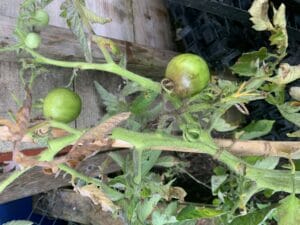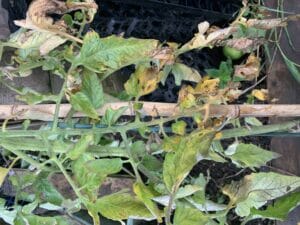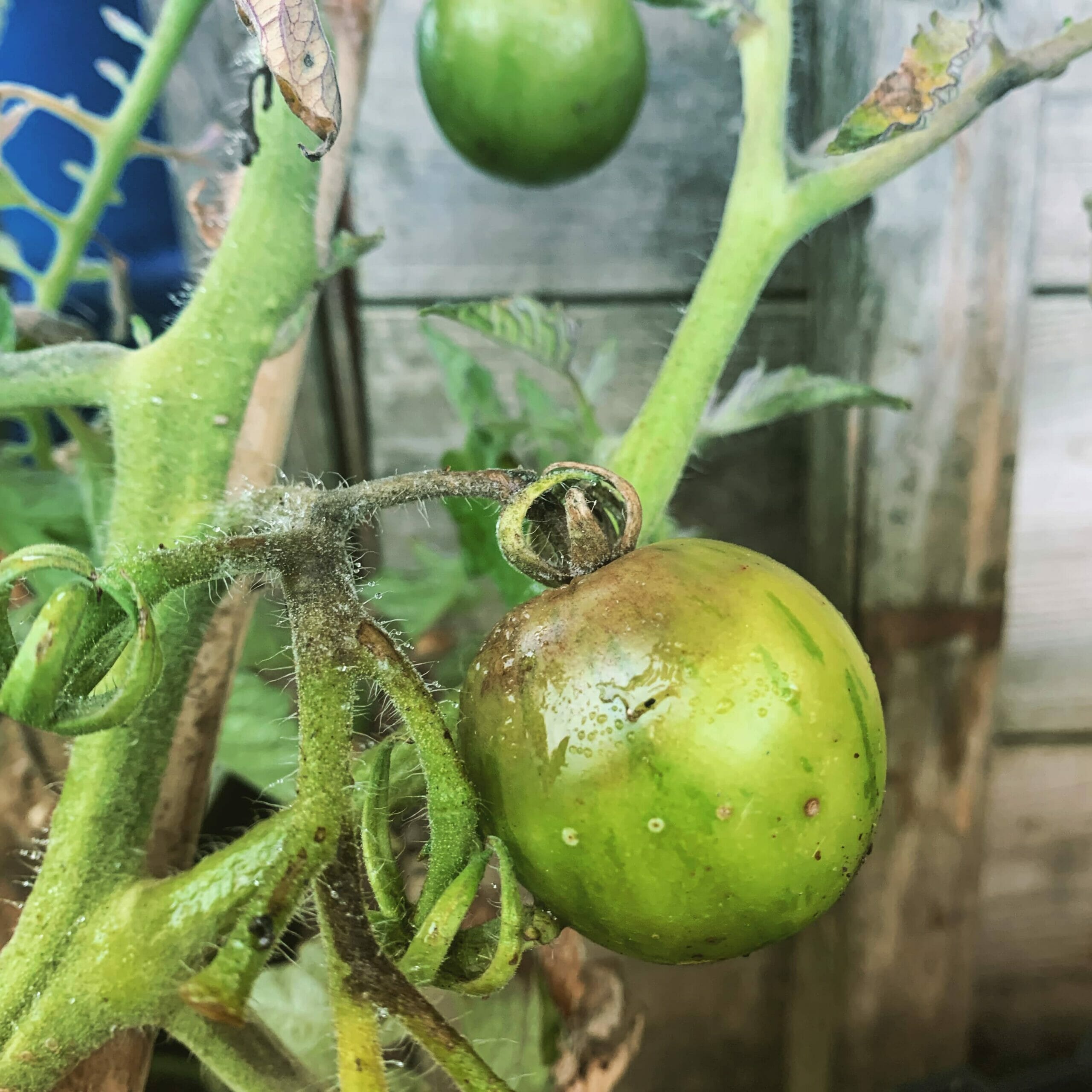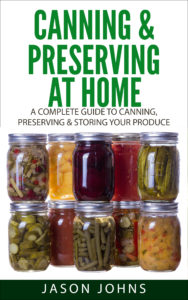Tomato blight, or late blight diseases (Phytophthora infestans), is a major issue for growers across the world. It can destroy crops and by the time it has infected your plants, it is too late for you to grow any more and your entire harvest is lost. Worse, late blight also affects potatoes, another crop commonly grown at home.
How To Spot Tomato Blight
Tomato blight cannot be spotted before it has infected and started killing your plants. It is a nightmare of a disease and can quickly ravage your plants, destroying all of your hard work. Tomato blight is a fungal disease that spreads rapidly through the fruit and foliage of tomatoes (and potatoes) in wet weather. Initially, it browns the leaves and stems but eventually causes them to collapse and decay.
Green fruit develop brown patches when they are infected with blight and ripe fruit decays very quickly. Even if you pick the fruit immediately, it will still rot very quickly.

How Tomato Blight Spreads
Tomato blight is quite common in outdoor grown tomatoes, but less common in those grown in greenhouses. This year, my outdoor tomatoes succumbed to blight in the middle of August, but by the end of September, those in the greenhouse were still going strong with no sign of blight.
This fungal disease spreads by spores in water, which is why you commonly see it in damp or wet weather. It spreads on the wind and from water splashes. The spores can travel over 30 miles on the wind, which is why even the most remote gardener can find their plants infected with this disease. It can start infected plants from around June time, in warmer areas, but it usually at its worst in late July and August, though now it is still infecting plants in September.
Avoiding Tomato Blight
As blight is spread by the wind, there is very little you can do to prevent blight. Unfortunately, if you are going to get it, then you are going to get it. However, there are some things you can do that will minimise the risk of it killing all of your tomato plants.
Firstly, if you can, grow your tomatoes in a greenhouse. As they can’t get rained on in a greenhouse, blight struggles to infect indoor grown plants. Just make sure, and this applies to outdoor grown tomatoes too, that there is sufficient spacing between your plants so the air can circulate and the plants can dry out. Also, be careful you do not bring the spores into the greenhouse on damp clothing or footwear, so avoid going to your greenhouse after visiting your outdoor tomatoes and potatoes. I always deal with my greenhouse first when visiting my allotment and then the rest of the plot so that I do not accidentally bring any pests or diseases into the greenhouse.
Water splashing helps to spread blight, so water at the base of your plants, avoiding getting the leaves wet and keep the watering can close to the ground to minimise splashing. Water first thing in the morning so the plants have plenty of time to dry off during the day and are not damp over night.
Feed your plants with a high potassium feed or a dedicated tomato feed rather than a generic feed high in nitrogen. High nitrogen fertilisers encourage leaf growth which increases the chance of blight.
As the plant starts to grow and produce tomatoes, remove the lower leaves so they cannot be splashed and remove some of the higher leaves to improve air circulation. If you are growing indoors, keep the plants well ventilated and do not allow water to pool, particularly near the plants.
Removing (and destroying) infected plant material at the first signs of infection will help to slow the progress of this disease, but it will not stop it as the rest of the plant is likely to be infected.
A 3-4 year crop rotation plan can help to reduce the risk of infection as it prevents the spores building up in the soil.
Avoid planting tomatoes outdoors anywhere near potatoes as blight infects both crops. Plant your tomatoes as far away from your potatoes as you can to reduce the risk of the plants infecting each other. Check your plants regularly from the start of summer for blight and immediately remove and destroy any infected plants.
Outdoor tomatoes can be covered with a tarp or other plastic root to stop the rain from hitting them. This will reduce the risk of infection by reducing water splashes. Mulching around the base of the tomato plants will also prevent splashing so can help reduce the risk of infection. Make sure your tomato plants are not trailing along the ground and are growing up canes.
Any infected plant material should be removed from your vegetable garden and destroyed. This includes any fallen leaves or tomatoes. Do not compost it as you run the risk of the spores living in the compost.
Early tomatoes, such as cherry varieties, ripen quicker than the larger varieties such as beefsteaks. This means they are less likely to be infected with blight because they are usually harvested before blight has taken hold.

Other Types of Blight
As well as late blight, which you know now all about, there is also early blight. Symptoms for this disease appear just after the fruits start to form with some small, brown lesions on the lower leaves. These grow and take on a target type shape and the leaf starts to yellow, then brown and eventually falls off the plant. Early blight does not affect the fruit, but does kill the leaves meaning the tomatoes then suffer from sun scald.
Septoria Leaf Spot is similar to early blight, though there tends to be lots of small brown spots rather than just a few. This does not normally affect leaves either.
Both of these types of blight will survive the winter in the ground whereas late blight cannot overwinter in the soil. It is important you practise crop rotation and remove all dead plant material at the end of the growing season.
Treating Tomato Blight
Unfortunately, there are no chemical treatments available to home growers to treat blight. While some people spray their potatoes with a copper based fungicide, this does not kill the blight and only slows it down. Nowadays, most copper based fungicides have been withdrawn from sale.

Blight Resistant Tomato Varieties
While there are some blight resistant tomato cultivars on the market, you need to remember that the important word here is ‘resistant’. They are not immune, but resistant varieties can give the plants the time they need to mature, or at least produce green tomatoes that are usable. Blight tolerant cultivars are not as protected as resistant varieties, but will put up a good fight against blight.
Some blight resistant varieties include:
- ‘Berry’ – a cordon tomato producing very sweet cherry tomatoes that ripen early plus has some resistance to blight.
- ‘Consuelo’ – a very blight resistant F1 variety producing large cherry tomatoes. Each plant can produce up to 150 tomatoes.
- ‘Crimson Crush’ – an F1 cultivar producing a good crop of large, very tasty tomatoes on indeterminate plants with excellent blight resistance.
- ‘Fandango’ – a cordon tomato producing medium sized fruits with a very good flavour. It tolerates blight and is resistant to both fusarium and verticillium wilt.
- ‘Fantasio’ – an F1 cordon tomato that produces a heavy crop of medium sized fruits. It tolerates blight and is resistant to both fusarium and verticillium wilt.
- ‘Latah’ – a bush tomato producing large cherry tomatoes very early in the season.
- ‘Legend’ – a beefsteak variety with few seeds and excellent flavour that has some blight tolerance. This variety has been awarded the RHS Award of Garden Merit.
- Lizzano – an F1 variety that is excellent in containers or hanging baskets due to its trailing habit. The round, cherry fruits are very sweet and the plant has good blight tolerance.
- Losetto – an F1 variety with high blight tolerance that produces lots of red, sweet, cherry tomatoes.
- ‘Mountain Magic’ – a great F1 variety to grow that is resistant to cracking, late blight and early blight. It produces a good crop of medium sized, sweet tomatoes.
- ‘Red Alert’ – a very early tomato plant with few leaves, producing lots of small, sweet cherry tomatoes.
- ‘Solito’ – a semi-determinate F1 variety, specifically bred for blight resistance. It produces very sweet orange coloured fruits and is ideal for containers.





